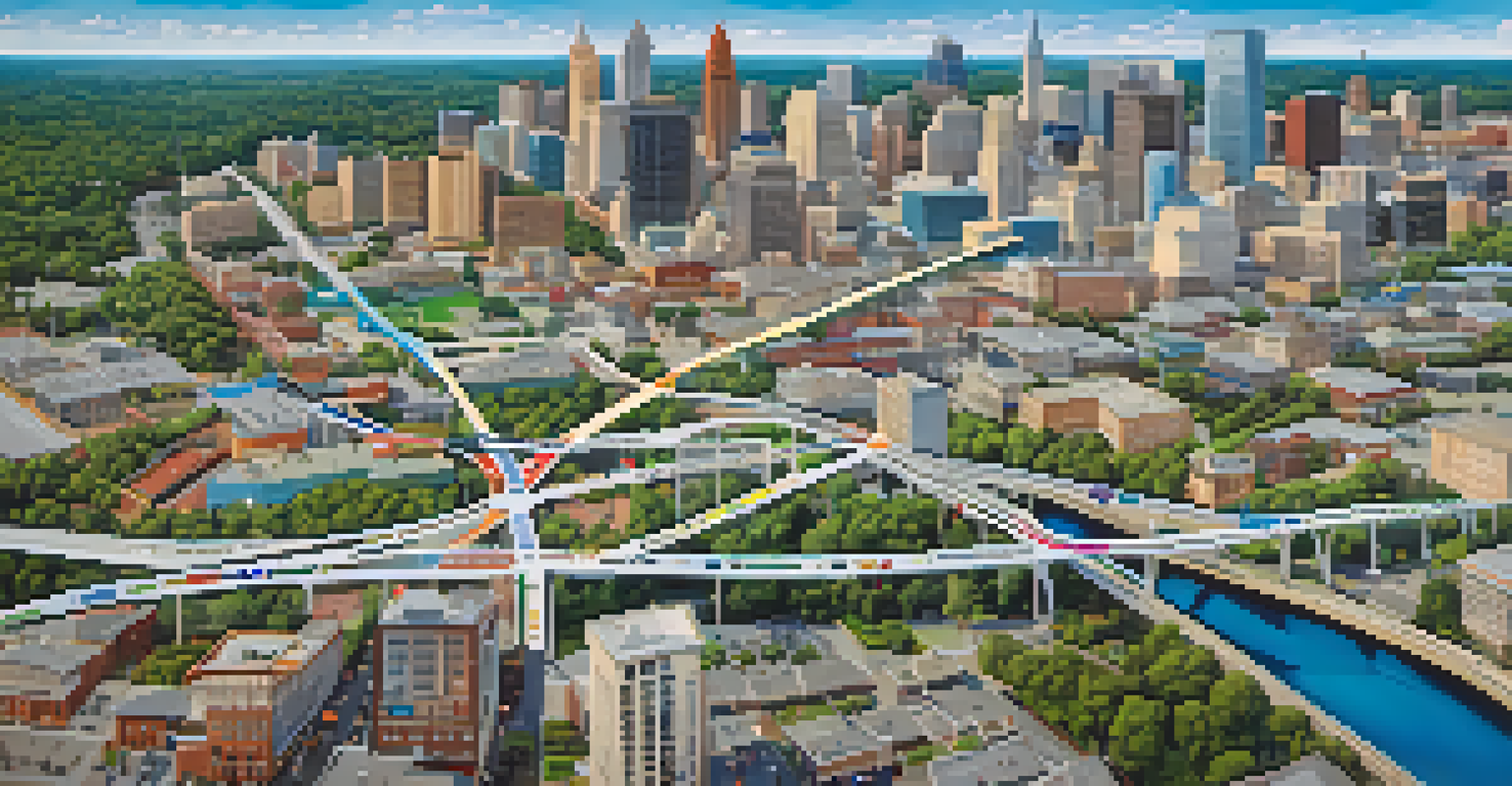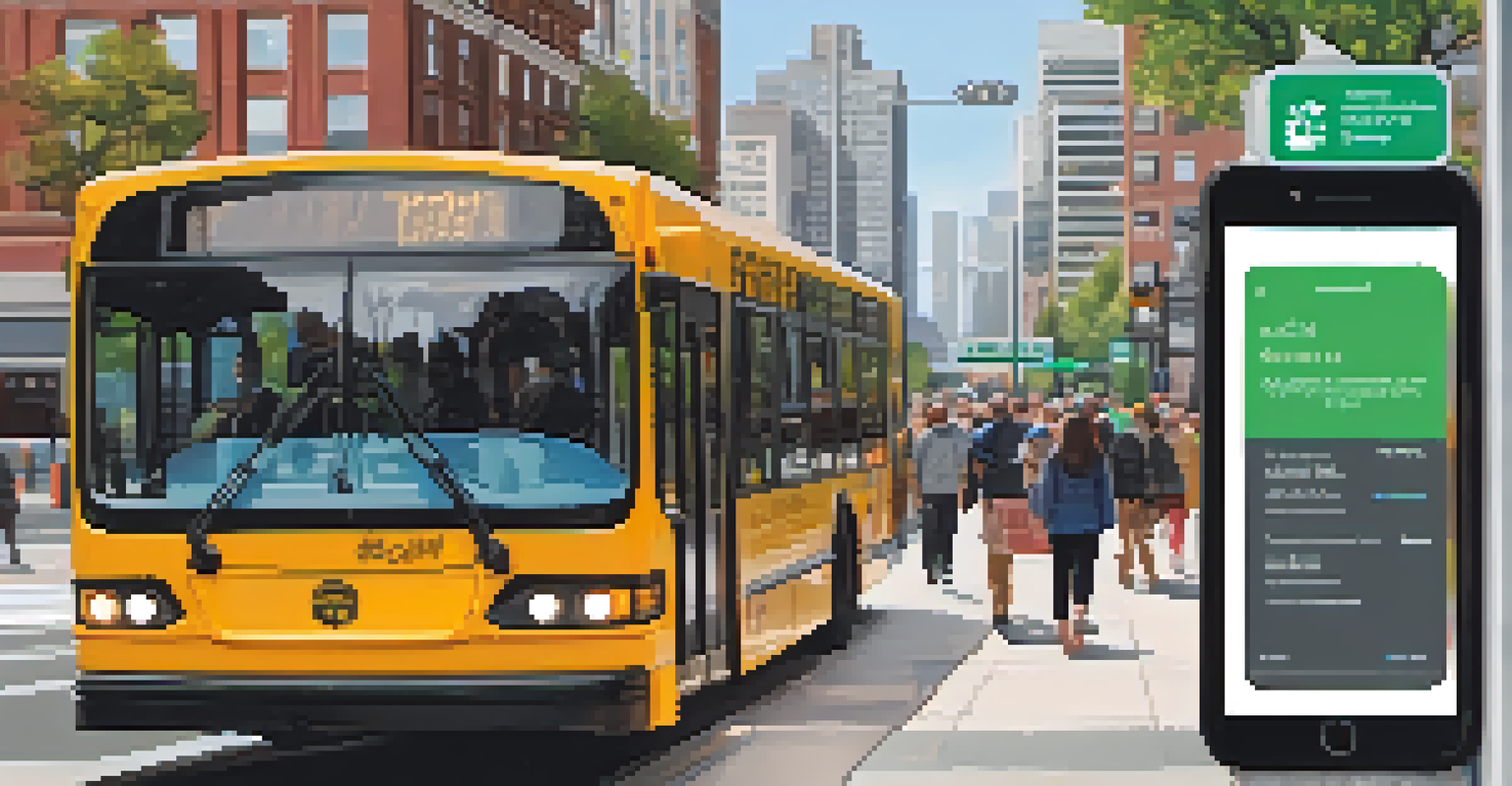Raleigh’s Intercity Transit: Connecting to the Greater Region

Overview of Raleigh's Intercity Transit System
Raleigh's intercity transit system serves as a vital link between the city and surrounding areas. With a focus on accessibility and efficiency, it connects residents to various regional destinations. This system not only facilitates commuting but also enhances the overall mobility of the region, making it easier for people to travel for work, education, and leisure.
Public transportation is the backbone of any city, providing access and opportunities for all its residents.
The transit network includes various modes of transportation, such as buses and shuttles, providing options for different needs. Service routes are designed to cover key areas, ensuring that residents have the ability to reach their destinations without the hassle of driving. As Raleigh continues to grow, the importance of a robust transit system becomes increasingly clear.
In addition to enhancing daily commutes, Raleigh's intercity transit plays a crucial role in promoting sustainable travel. By providing an efficient alternative to personal vehicles, it helps reduce traffic congestion and lowers carbon emissions. This shift not only benefits the environment but also improves the quality of life for residents.
Key Routes and Destinations Served
Raleigh's intercity transit system features several key routes that connect major destinations in the Greater Region. For instance, routes to Durham and Chapel Hill are particularly popular among commuters and students. These connections make it easy for individuals to access universities and workplaces, fostering a sense of community across the region.

In addition to work-related travel, these routes also connect residents to cultural and recreational activities. Whether it's a day at the museum in Raleigh or a concert in Durham, the transit system opens up a world of possibilities for exploration. This easy access encourages residents to engage with their surroundings and supports local economies.
Transit Boosts Local Economy
Raleigh's intercity transit system enhances economic growth by improving accessibility to jobs and attracting new businesses.
The strategic planning of these routes ensures that they are both efficient and user-friendly. With regular schedules and well-placed stops, passengers can rely on the transit system to get them where they need to go without unnecessary delays. This reliability builds trust in the system and encourages even more people to use public transportation.
The Impact of Transit on Local Economy
A well-connected transit system can significantly boost the local economy, and Raleigh is no exception. By making it easier for people to travel to jobs and businesses, the intercity transit network contributes to economic growth. This accessibility attracts new businesses and can lead to job creation in the area.
The best way to predict the future is to create it, and investing in public transit is a step towards a sustainable future.
Moreover, the transit system supports sectors like tourism and hospitality. Visitors can easily explore the attractions in Raleigh and nearby cities, contributing to a thriving tourism industry. Events, festivals, and conferences become more accessible, benefiting local vendors and service providers.
Investing in transit also signals to potential residents and businesses that Raleigh is committed to a sustainable and vibrant future. As more people choose to live in transit-friendly areas, property values may increase, further enhancing the local economy. It’s a positive cycle that benefits everyone.
Sustainability and Environmental Benefits
Sustainability is at the forefront of Raleigh's intercity transit initiatives. By promoting public transportation, the city helps to reduce reliance on single-occupancy vehicles, which contributes to lower greenhouse gas emissions. This shift not only helps fight climate change but also improves air quality for everyone.
Furthermore, the transit system incorporates eco-friendly practices, such as using energy-efficient buses. These efforts demonstrate Raleigh's commitment to protecting the environment while providing essential services to its residents. As more people embrace public transit, the collective impact on sustainability grows exponentially.
Sustainability Through Public Transit
The transit system promotes environmental responsibility by reducing reliance on single-occupancy vehicles and lowering greenhouse gas emissions.
By encouraging the use of public transportation, Raleigh is fostering a culture of environmental responsibility. This mindset not only helps residents feel good about their choices but also inspires future generations to consider sustainable practices. It’s an investment in the planet’s health that pays dividends for years to come.
Challenges Facing the Transit System
While Raleigh's intercity transit system boasts many benefits, it also faces several challenges. Funding and resource allocation can be significant hurdles, especially as demand for services continues to grow. Ensuring that the system remains efficient and effective requires ongoing investment and community support.
Another challenge is the need for public awareness and education about the transit options available. Many residents may not fully understand how to navigate the system or the benefits it offers. Engaging the community through outreach programs can help bridge this knowledge gap and encourage more people to utilize the transit services.
Additionally, infrastructure improvements are necessary to keep pace with the city's growth. Upgrading bus stops, ensuring accessibility, and enhancing scheduling can all contribute to a more user-friendly experience. Addressing these challenges proactively will be key to the long-term success of Raleigh's intercity transit.
Future Developments in Transit Services
Looking ahead, Raleigh's intercity transit system is poised for exciting developments. Plans for expanding routes and enhancing service frequency are on the horizon. These improvements aim to meet the increasing demand from a growing population and ensure that transit remains a viable option for everyone.
Technological advancements are also set to play a role in the future of Raleigh's public transportation. The integration of mobile apps for real-time tracking and fare payments can streamline the user experience, making it easier for passengers to plan their trips. Embracing technology can significantly enhance the appeal of the transit system.
Future Enhancements Coming Soon
Plans for expanding routes and integrating technology aim to improve Raleigh's transit system and meet the needs of its growing population.
Moreover, ongoing community engagement is vital for shaping the future of transit in Raleigh. Input from residents can guide decision-making and ensure that the transit system meets their needs. By fostering a collaborative approach, Raleigh can build a transit network that truly serves its diverse community.
How to Utilize Raleigh's Intercity Transit
Utilizing Raleigh's intercity transit is straightforward and accessible for everyone. To get started, residents can visit the transit website for route maps and schedules. Familiarizing yourself with the available services will empower you to plan your trips effectively, whether for work, school, or leisure.
Additionally, many transit services offer user-friendly mobile applications that provide real-time updates on schedules and bus locations. These tools can help passengers minimize wait times and make informed decisions about their travel plans. By embracing these resources, you can navigate the transit system with confidence.

Lastly, don't hesitate to reach out to the transit authority for any questions or assistance. They often have customer service representatives ready to help residents understand the available options. Making the most of Raleigh's intercity transit is about being informed and engaged, paving the way for a more connected community.